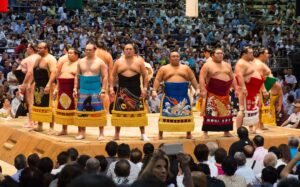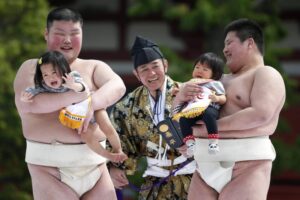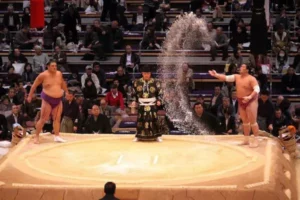
Il sumo (相撲 ) is the national sport of Japan; it is a form of fight in which two huge challengers face each other with the aim of knocking down or ousting the opponent from the combat zone, a circular clay platform covered with sand, called dohyō. The wrestlers are exclusively men because women, in addition to being forbidden to participate in fights, are not allowed to set foot in the ring.
Actually sumo is a religious ritual and the ring represents a sacred place. Its origins are very ancient, probably around the sixth century, and it was offered as entertainment for the gods during Shinto rites to invoke abundant rice harvests. It was mainly practiced in feudal times: more and more wrestlers were recruited by the clans warriors not only because they are believed to have enormous physical strength, but also due to their almost divine naturewhich instilled fear and awe.
 Even today you can see the correlation between sumo and shintoism in the ritual of “I have learned” during which two wrestlers, rikishi, they pick up newborn babies and make them compete in a very extravagant way, the baby who bursts into tears first wins. This “fight” is considered a good omen as it is thought that the crying of children drives away evil spirits.
Even today you can see the correlation between sumo and shintoism in the ritual of “I have learned” during which two wrestlers, rikishi, they pick up newborn babies and make them compete in a very extravagant way, the baby who bursts into tears first wins. This “fight” is considered a good omen as it is thought that the crying of children drives away evil spirits.
On the dohyō the wrestlers and the referee go up. L‘referee of the fighting is called Gyōji e holds a fan in hand to highlight his authority and a dagger around his belt, in memory of the ancient tradition in which in case of incorrect evaluation of the result, he would have committed suicide. He mounts the Dohyo first and announces the wrestlers by shouting their names out loud (not using the microphone but the natural voice). The tone is “super solemn” according to the Japanese tradition with particular and exciting sounds. When the result appears doubtful, the side referees discuss the dohyō and decide who to give the victory to. If a verdict is not reached, the match is replayed. There are no meetings that end up “even”.
 A sumo match consists of several stages:
A sumo match consists of several stages:
Dohyoiri: the sumo wrestlers climb the dohyō to be presented to the public, they wear a sort of stiff silk apron, the keshomawashidecorated with emblems and writings that identify the sponsors, and perform a superstitious ritual to ward off evil.
Yokozuna dohyoiri: at the end of the ritual the best wrestlers enter the ring, the yokozuna, and are welcomed with a ceremony dedicated to them; at this point the fight can begin.
The throwing of the salt: before each meeting the rikishi, who have changed and wear a loincloth said mawashisprinkle the dohyō with salt, as it is believed to have purifying powers and to keep evil influences away from the ring.
Lo Look: this is one of the most characteristic and important elements of sumo because the rikishi, by lifting their leg and banging their foot loudly on the ground, scare away evil spirits and make them escape from the dohyō.
 A moment of the Shiko
A moment of the Shiko
Lotta: at this point the fight begins which can last from a few seconds to a few minutes, depending on how long the rikishi takes to knock down the opponent or get him out of the dohyo. Bow dance: a young rikishi performs with a bow , symbol of strength and victory, to indicate the end of the fight.
During the fight, the wrestlers must pay attention to the regulation which provides for these techniques “Kimarite” and they all have the aim of winning the match. Of the 82 techniques, the following can be highlighted:
Nagetethrowing techniques, to throw the opponent to the ground or off the dohyō
Kaketesweeping techniques, to throw the opponent off balance
Hineritethrowing techniques, to “back” the opponent directly
Soritetechniques of falls of the body backwards, to “back” the opponent by falling
To these actions are also added the “Kinjite Hansoku” , irregular actions, which include among others the blows to the genitals, the grabbing of the hair, punches, kicks, fingers in the eyes and innumerable other prohibited actions which mark the admonition of the wrestler. It is strictly forbidden to lose the mawashi by remaining naked in the dohyo, on pain of immediate defeat.
There are six official Sumo tournaments in Japan. In January, May and September a Tokyothe most important city for this discipline, one a Osaka in Marchone to Nagoya in July and finally one a Fukuoka in November.
The tournaments begin on Sunday and last 15 days, during which each rikishi faces all opponents, one a day. To maintain one’s rank and hope to advance in rank, one must win more than half of the matches and the one who has accumulated the most total victories will be declared the winner of the competition. To aspire to title of yokozunaas well as possessing moral qualities and worthy achievements, one must win two tournaments in a row.
To attend a Sumo tournament the advice is to andare al “Ryogoku Kokugikan” stage of Tokyo in which 3 of the 6 national tournaments are held. Ticket prices depend on the location with respect to the Doyhō, the closer you are the higher the price. However, the cost of the cheapest tickets is around 40 Euros.
 The charm of sumo is exalted not only in history books and stadiums, but also in anime Hinomaru Zumo; the reader gets involved in the exploits of Ushio Hinomaru who decides to join the sumo club, a circle that does not enjoy any glory. The boy will do his best to reach the top and the highest rank in sumo, bringing fame and success to the club as well.
The charm of sumo is exalted not only in history books and stadiums, but also in anime Hinomaru Zumo; the reader gets involved in the exploits of Ushio Hinomaru who decides to join the sumo club, a circle that does not enjoy any glory. The boy will do his best to reach the top and the highest rank in sumo, bringing fame and success to the club as well.
By Valeria Turino
